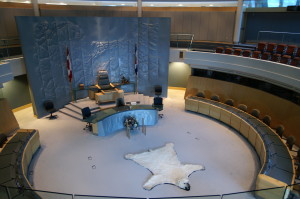I had an unusual experience last December, facilitating a priority planning session for the incoming members of the 18th Legislative Assembly in the Northwest Territories. I had never been in Yellowknife, or so far north anywhere, and that alone was fascinating. But what really struck me during my visit was that the Assembly works by consensus, without political parties through which to structure governance.
Our American and Canadian governance systems rely on political parties, hoping that law and custom will contain the adversarial interactions inherent in party politics from spilling too far outside reasonable bounds.
The United States is a federal constitutional democracy designed so that Congress, the President and the Judicial System each have defined functions that check and balance the others. In practice the United States has two political parties that compete for elected office, and the system used to work reasonably well. Since any of the three government branches could overrule the others, compromise and conciliation became practical elements of the political landscape in between the more vitriolic campaign periods.
The need to govern within the boundaries formed by this balanced three-tiered system served to keep the worst impulses of politicians in check. But as any follower of American news knows, the system has gone seriously off the rails, becoming a caricature of what the founders had envisioned when writing the U.S. constitution.
The Canadian system is Parliamentary, with a number of political parties competing for seats in Parliament. The Prime Minister is the head of the party with the most votes. If he or she wins a majority of seats, their party has full control over the legislature, whereas a minority government requires more compromise between the leading party and the others. A Senate is appointed, and has limited power, but the judiciary is strong and to some extent keeps the government restrained.
This system served Canada well until recently, in part because there was a culture in Parliament of the governing parties respecting the opposition. This system broke down with the government led by Conservative Stephen Harper that trampled over Parliamentary traditions, resulting in voters turfing that government out and electing the Liberals who promised more conciliation.
The 19 members of the Northwest Territory’s Legislative Assembly run for office in their home ridings as individuals rather than as members of a party. Voters pick the person they believe will best represent their interests, and each is in office without the constraint of having to support a platform determined by a central political party. Most significantly, they are culturally and by law expected to work together to govern, rather than divide into politically fragmented segments competing with each other.
One advantage of consensus government is that it favors careful consideration of issues on merits rather than dogma. I found it difficult to categorize the members of the Assembly as left or right wing, liberal or conservative. Discussion was nuanced, reflecting the reality that issues are complex rather than the simplifications that political parties rely on to differentiate their positions from the others.
The tone of discussions also was refreshing, avoiding debate and supporting dialogue. Attack mode was missing, interactions substantive but respectful and ideas delivered thoughtfully. A tone of listening to all viewpoints permeated the room, and discussion continued until everyone who wanted to had their say.
There certainly was disagreement, but it was fascinating to see how different opinions were resolved. For one thing there was a remarkable lack of conflict. Disagreement, yes, but skirmishes and battles were absent. Most notably, issues didn’t become personal but were discussed respectfully on their merits. After listening to the caustic personal attacks that permeated the recent Canadian and the current American elections, it was most refreshing to hear tones of respect rather than personal denigration.
Another compelling aspect of how consensus government resolves disagreements is that decisions are made less by vote and more by slow evolution towards communally acceptable positions. In a typical exchange, one member of the legislature will raise a point that may differ from another. The group talks around the issue until all points are raised, but in a direction that seeks agreement.
Compromise is paramount, worded in language such as “Here’s an idea; do you think it will resolve your concern?” Indeed, this was a striking aspect of my time with the Assembly; discussions didn’t lead towards hardening of perspectives but rather softening of the boundaries between positions.
Whatever the mechanism, consensus government supports another “c” word sadly lacking in political interactions: “Civility.” It was uplifting, and invigorating, to see that civility can work in government, without the circus arena that today characterizes the Canadian Parliaments and Assemblies, and the U.S. Congress and state governments.
The Canadian north may be small in population, but it is huge in ideas that we in the south would be well served to learn from.
————————-
I’d love to hear your thoughts.
